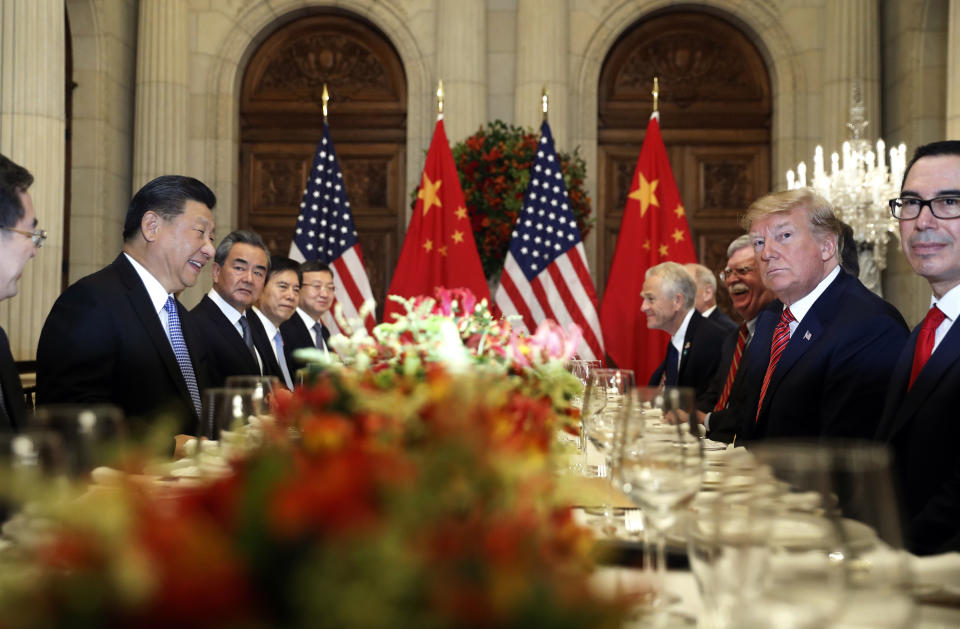Stocks pare losses on news that China's delegation will head to US
Stocks reversed most of the session’s losses on Monday, as President Donald Trump’s threat to slap higher tariffs on Chinese goods was momentarily offset by news that a delegation from China would visit the U.S., stoking optimism that a trade dispute between the world’s largest economies could be settled.
Via Twitter on Sunday, the president said that insufficient progress in bilateral talks would prompt him to hike duties on certain Chinese goods as early as Friday. Those tariffs were originally held in abeyance pending the outcome of trade talks.
After opening over 400 points lower, stocks pulled higher after CNBC reported that a negotiating team from Beijing would head to Washington, after earlier reports suggested they might cancel.
By market close the Dow Jones Industrial Average was down by about 67 points, sharply off the day’s lows. The S&P 500 was off by 13 points, while the Nasdaq shed around 40 points.
The president, a self-described “tariff man” who believes the trade imbalance can be whittled down with the use of import duties, explicitly linked U.S. growth to the imposition of Chinese tariffs.
....of additional goods sent to us by China remain untaxed, but will be shortly, at a rate of 25%. The Tariffs paid to the USA have had little impact on product cost, mostly borne by China. The Trade Deal with China continues, but too slowly, as they attempt to renegotiate. No!
— Donald J. Trump (@realDonaldTrump) May 5, 2019
The announcement sent the Dow (^DJI), S&P (^GSPC) and Nasdaq (^IXIC) into a tailspin overnight, despite last week’s blowout employment data. The S&P 500 was up 17.5% for the year-to-date through Friday’s close.
The ratcheting up of trade tensions “likely [means] risk-off to start the week as China returns from the extended May Day holiday,” said Marc Chandler, chief market strategist at Bannockburn Global Forex. “In equities, this means downside risks.”
Indeed, traders fled to safe haven investments, with the Japanese yen higher against the U.S. dollar (USDJPY=X) Monday morning and gold prices (GC=F) on the ascent. U.S. Treasury yields, which move inversely to prices, fell across the curve, with the yield on the 10-year U.S. note, dropping 4.6 basis points, or 2.484% Monday afternoon.
Crude oil (CL=F) – considered a risk asset – tracked the drop in equities before paring losses at settlement, with earlier declines in the commodity’s prices exacerbated by news of a U.S. plan to deploy a carrier strike group and bomber task force to send a warning message to Iran.
The CBOE Volatility Index (^VIX), the so-called “fear gauge” looked to as a proxy for market risk, rose to as much as 18.8 Monday morning, the highest since the end of January.
What analysts are saying
Monday’s early trading action suggests markets are increasingly pricing in the outcome of a rockier end to trade talks than had previously been anticipated.
“The market was basically fully priced for a positive outcome on U.S.-China trade talks given the prior positive comments from both sides, hence the sharp fall in [the offshore Chinese yuan] this morning and generalized pressure on risk assets reflect a meaningful adjustment in the probability of a positive outcome anticipated by the market,” Jason Daw, head of emerging markets strategy at Societe Generale, wrote in a note.

However, some analysts believe the pullback will be short-lived, given that the U.S. appears to be operating from a position of relative economic strength compared to China.
A deep selloff “would need to be predicated on an escalation of tensions – one where China threatens further retaliation, thus triggering another painful cycle of falling confidence, disrupted order books, inventory correction and downturn in PMIs,” Tom Lee, managing partner at Fundstrat Global Advisors, wrote in a note Monday. “Given that [the] U.S. has demonstrated relatively strong economic resilience while China has demonstrably weakened, it is not clear that China has a strong hand to play in that regard.”
The current pullback may in fact present a buying opportunity, Lee added.
“2019 is proving the [sell the rallies market of 2018] was an anomaly born out of a market overly complacent with risks. 2019 has seen a rally met with skepticism and doubt,” he said. “Thus, we expect funds to buy this dip.”
Other analysts expressed confidence that further trade tension escalation might yet be avoided.
According to Goldman Sachs economist Jan Hatzius, the administration’s announcement to raise the tariff rate “lower the odds of a successful conclusion to U.S.-China trade talks and raises the odds of further tariff escalation.”
“However, we think it is more likely that the increase will be narrowly avoided and believe the odds of tariffs increasing on Friday are 40%,” Hatzius wrote in a note Sunday.
This week, delegations from China and the U.S. were scheduled to meet in what was expected to have been a final round of talks before a potential deal.
By Hatzius’ reckoning, if the delegation of Chinese officials comes to Washington on May 8 as scheduled, it “would indicate that they believe a deal is still reasonably likely” – a scenario which appears to be on the table as of Monday afternoon.
For the better part of the last year, the U.S. has levied a 25% tariffs on $50 billion worth of Chinese high tech imports, and 10% tariffs on $200 billion of other goods. If Trump makes good on his threat, the 10% tax that’s been on hold since Jan. 1 will jump to 25% — likely sparking retaliation from Beijing.
Trump’s shift—coming after weeks of encouraging talk that raised expectations that the two sides were inching toward a deal—threw into doubt the status of negotiations.
Yahoo Finance’s Javier E. David contributed to this report.
—
Emily McCormick is a reporter for Yahoo Finance. Follow her on Twitter: @emily_mcck
Follow Yahoo Finance on Twitter, Facebook, Instagram, Flipboard, LinkedIn, and reddit.
Read more from Emily:

 Yahoo Finance
Yahoo Finance